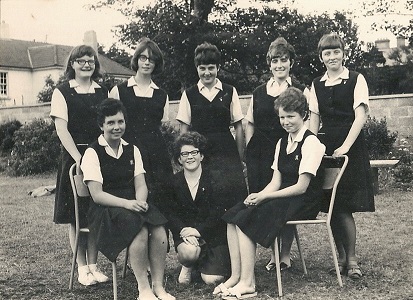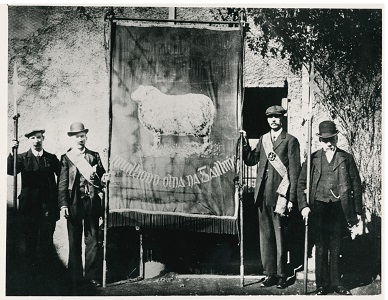Old Galway
THE SALMON WEIR BRIDGE

by Tom Kenny
The Foundation stone for this bridge was laid on June 29th, 1818, by William Le Poer Trench and the structure was completed the following year. The original purpose was to connect the new County Courthouse with the County Gaol on Nun’s Island. It is a fine gently humped five-span bridge which was originally known as ‘The New Bridge’ or ‘Gaol Bridge’.
The major public works scheme begun during the Famine which constructed the canal, steamer’s Quay, and built up the banks on each side of the river, resulted in excavations of the depth of the river which necessitated the underpinning of the piers and abutments of the bridge to an extent of 7 feet. This was completed with ashlar masonry of a character which was suitable to that of the bridge.
Just above the bridge was the weir which backed up the water above it to afford power for some dozen mills through the 19th century.
THE GALWAY SHAWL

by Tom Kenny
The Galway Shawl was a specific type of heavyweight shawl worn by women during the cold season. It was very popular during the 19th century and was still being worn by a few older more traditional women up until the 1950s. It was worn by women all over Ireland, but for some reason, was known as the Galway Shawl. It was a winter-weight outer garment and was worn over a lightweight one.
The Galway Shawl was woven on a hand jacquared loom in Paisley, Scotland, but used neither the design nor the construction of the Paisley shawl. The Galway version was woven on a cotton warp with a weft of botany wool. These reversible shawls were a solid colour in the centre with a decorative multi-coloured wide border and they were fringed. The solid colour was often fawn and the border design was usually in browns and reds. They contained neither velvet nor fur but were referred to as such because they were heavily milled in the finishing and a soft velvet-like nap was raised on the surface. In 1892, one Paisley company employed 40 weavers making these shawls. The garments were sent to the Galway Woollen Mills where the fringes were applied.
OF CLOAKS IN OLD GALWAY

by Tom Kenny
The Irish cloak was a standard 19th century garment worn by women all over the country. It is described as a sleeveless garment reaching to the ankles, open in front and fastened with a hook-and-eye or with ribbons. One width of material goes into the back and a half width into each side. On the shoulder, the material is tightly gauged and attached to the back of the neck is a large hood which hangs down the back when not in use. The hood, which is lined with satin, silk or sateen is made of a rectangular piece of material drawn into pleats at the back. It was constantly used when the cloak was worn, even on hot days when the hood could be drawn to shield the eyes of the wearer from the sun. The cloak formed very graceful drapery, fell well and folded well, was very elegant and usually large enough to envelop the whole person.
According to the historian James Hardiman, the ancient Irish habit for a woman consisted of “A blue mantle, a red body gown, a petticoat of the same colour and a blue or red cotton handkerchief bound around the head. On Sundays and festivals, however, they make a more modern appearance, a matron’s dress being generally composed of a blue rug cloak trimmed with fine ribbon, a rich calico stuff gown, with the flannel body-gown, however, occasionally, worn over it, and a silk handkerchief on the head”.
WAR OF FRIENDS, LIAM MELLOWS & PÁDRAIC Ó MÁILLE

by Tom Kenny
Today we are highlighting the careers of two men, both of whom were elected as TDs for Galway in 1918, both of whom fought on the same side in the Rising and the War of Independence and then, sadly, took different sides after the treaty.
Liam Mellows was born on May 25th, 1892, in Ashton-on-Lyne in England. His father was an NCO in the British Army, his mother Sarah (née Jordan) was from Co. Wexford. The family moved to Dublin when he was three years old. He was educated at a number of military schools in Dublin and Cork. He became an Irish nationalist from an early age, Tom Clarke recruited him into Fianna Éireann and on April 7th, 1911, he was sworn into the IRB. He was a founding member of the Irish Volunteers who gave him a full-time job.
AN HISTORIC AIR MAIL FLIGHT FROM GALWAY TO BERLIN

by Tom Kenny
Ninety years ago, on October 22nd, 1932, a Fox Moth plane piloted by Captain Armstrong took off from Oranmore carrying mails and two passengers, Peggy Kenny and Kitty Curran, thus starting the first Irish–Continental European air mail delivery and the first passenger service. The mails were handed to the pilot by the postmaster Mr. C. Lynch. Bad weather at Athlone meant they had to fly blind a few hundred feet above ground for some time. This ‘feeder’ part of the overall journey was sponsored by Galway Harbour Board to the tune of £80. The flight took 55 minutes, it took the ladies four hours to get home on the train.
At Baldonnel, 14 passengers boarded the 30-seater monoplane (described as a ‘giant plane’) which was piloted by Col. Charles Russell, and 45 minutes after the arrival of the plane from Galway, they took off. They had taken on some extra mail to add to the mails from Galway. They landed in Croydon at 11.55am to refuel. Their next stop was Rotterdam which they reached at 1.05pm, had a quick bite to eat and took off for Berlin at 1.45pm. As they passed Brandenburg, their attention was drawn to lights that flashed every thirty miles guiding aircraft to Berlin. “The aerodrome – the best and most up to date in the world – lights two or three acres with red lights among the grass to guide us down, a runway of white lights standing out for the final landing.”
SALERNO, 60 YEARS OF SECONDARY EDUCATION

by Tom Kenny
In the late forties and early fifties, the population of Salthill began to grow dramatically with the building of lots of individual houses and estates such as Devon Park and Ardnamara. There was a national school at Nile Lodge but it was full to capacity, so the bishop invited the Sisters of Jesus and Mary to open another one.
They took over a small hotel known as Dalysfort House and converted it into a school called Scoil Íde which opened on May 1st, 1952. They began with 43 pupils, but this number increased very rapidly making the building too small, so they demolished it and built a new school to cater for 450 students. This opened on July 2nd, 1962 and that year they opened a ‘secondary top’, a secondary school class housed in their building. Two years later, this little secondary school had three classes.
THE GALWAY WOOLEN MILLS

by Tom Kenny
In 1895, the Galway Woolen Mills opened in Newtownsmith on land that was owned by Marcella Burke. The project was set up to provide employment, especially for young women, rather than to generate profits. Fr. Dooley, the diocesan administrator, was the driving force behind the project and it was known locally as “Fr. Dooley’s Mill’ long after he died in 1911. He took over three houses in order to build the mill. The hours were long and the pay was not great, 7/6 for women and 18 shillings for men.
It became a successful business. Just before WW1, the wage bill was £5,000, after the war it was £15,000 and in 1919, profits to the amount of £5,772 were distributed among the staff.
THE CORRIB HOSIERY FACTORY

by Tom Kenny
This factory was situated in Newtownsmyth in a tall building that later became part of the ESB complex. It was quite a big employer of the day in the city, employing mostly young girls and women.
It was described thus by Jane Hackett (née Gallagher) as follows, “I really didn’t have to apply for the job. There was this woman, a manageress, Nellie Kavanagh – She was Mrs. Hehir afterwards – who lived over in Woodquay in McDonagh’s Terrace, and my mother asked her was there any vacancies in the Hosiery, and she said ‘Send her over on Monday morning’. She said she’d see the manager and that’s how I got the job. It was very well looked after, a clean place to work, very spacious. You weren’t confined. There were different sections. On the ground floor there were the looms and upstairs you’d have the winding.
